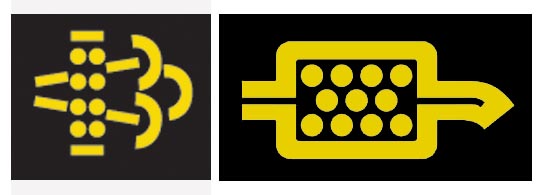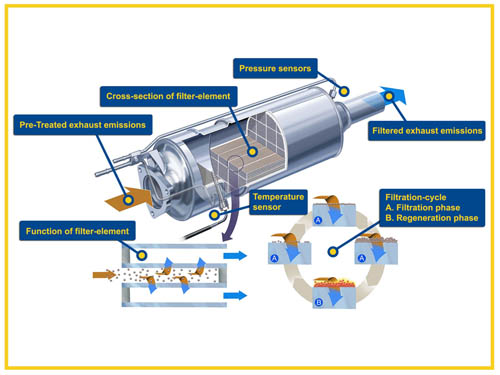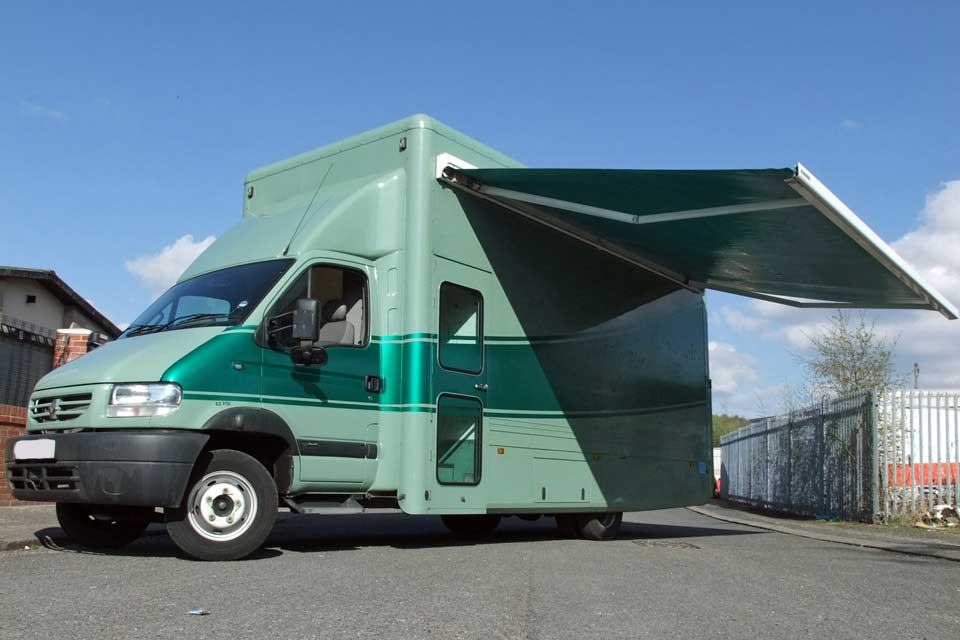DPFs What Drivers Need to Know About Diesel Particulate Filters
The majority of drivers are in the dark about what Diesel Particulate Filters (DPF's) actually do, why they do it - and how to maintain and extend their serviceable life.

If you drive a modern diesel van or car, chances are that it has a DPF installed, yet you probably won't t even know about it. That is until you see a warning lamp on your dashboard similar to these, by which point you may have a costly problem! Fear not, diesel driver, because here we've tried to explain the main information you need to know about DPFs, what they do, what can go wrong with them, and what you can do to help reduce the regularity of seeing one of these warning lamps.
Environmentally friendly, Diesel Particulate Filters are fitted to some diesel vehicles manufactured after 2008 and all diesel-engined vehicles registered from 2011 onwards; but despite helping the environment they may be causing motorists a problem - especially those urban drivers who are not driving long distances.
What is a DPF?
In order to meet modern Euro 5 & Euro 6 regulations on exhaust emissions, modern diesel vans and cars are now fitted with a DPF which basically works as a 'filter box' within the exhaust system, to capture soot and harmful particulates emitted from the engine and prevent them being released into the atmosphere. They can reduce particulate emissions by between 80-99% and are now as common as catalytic converters on petrol-fuelled cars. A diesel-powered vehicle fitted with a DPF will emit less particulates than a petrol-powered vehicle. In fact, these filters are so efficient at collecting particulates that the exhaust gas from a vehicle equipped with an additive DPF system will contain fewer particulates than the air that enters the engine!
DPFs are here to stay and if you're purchasing a new van, or a used van of only a few years old, you won't have a choice over the fitment of a DPF (unless you buy a petrol!). The vehicle and engine manufacturers have had to include an exhaust filter in the design of their later models, in order to comply with the more stringent Euro 5 and Euro 6 exhaust emissions regulations (most Euro 6 vehicles also incorporate an additive called AdBlue to reduce NOx emissions).
How does a DPF work?
Harmful exhaust deposits accumulate and build up within the filter element; a honeycomb-like structure of minute tubes, which run from the front to rear of the filter casing. These deposits build up within the filter as the vehicle is driven and they have to be regularly removed, through a process called 'regeneration' where the majority of the accumulated deposits are burnt off, leaving only a tiny amount of residual ash. There are three types of DPF regeneration; 'Passive', 'Active' and 'Forced'.
Here's an excellent diagram to explain the process, courtesy of http://www.ndbautos.co.uk

Passive regeneration takes place automatically during lengthy, high-speed journeys - such as motorway travel - when the exhaust reaches a high temperature. Many vehicles don't get this sort of use on a regular basis (e.g. vehicles based in towns & cities, ones which are only used for short commutes), so vehicles have a built-in Active regeneration system. Simply put, the engine management module (ECU) automatically takes over the process. When the deposits in the filter reach a pre-determined level (around 45%) the ECU will superheat the exhaust temperature and start regeneration.
If the journey is too short whilst the regeneration is in progress it may not fully complete - and could result in a warning light to show that the filter is partially blocked.
Unfortunately there are many factors which govern the success of both Passive and Active regeneration processes... such as low fuel (most systems require a minimum of 1/4 tank before they will allow regeneration), engine temperature (frequent short journeys will mean that the engine does not reach normal operating temperature), type of engine oil used (most engines with DPFs require low Sulphated Ash, Phosphorous, Sulphur - or Low-SAPS - engine oils), even an illuminated dashboard warning light or an exceeded service interval can prevent the regeneration process working correctly!
The majority of exhaust gas particulate filtration systems regenerate through generating a high level of heat within the exhaust which burns the particulate deposits and less harmful by-products. Some manufacturers such as PSA Peugeot/Citroen also use an additive to aid the regeneration process. This liquid additive is a catalyst added to the fuel that reduces the soot combustion temperature by around 100-150°C, bringing the regeneration temperature down from 650°C to 500°C maximum. This makes the regeneration process easier and more effective, lowering fuel consumption and improving efficiency in urban driving conditions. Some models which use additives have a separate tank which requires topping up every few services, whilst others have a disposable vessel which needs to be replaced altogether when empty. Further information can be found on the PSA Peugeot Citroen DPF technology information page: http://www.psa-peugeot-citroen.com/en/featured-content/diesel-technology/DPF-diesel-particulate-filter and in the following video:
If you ignore the DPF warning light, soot deposits will continue to build up until around 75% when you can expect to see additional dashboard warning lights illuminate, which will most likely result in the engine entering a self-preservation programme commonly known as "Limp Home Mode". In limp home mode (also known as "Limp Mode") the performance of the engine is severely restricted in an attempt to allow the driver to get home or to a repairer safely whilst limiting further damage being caused. At this point you will have no option but to take the vehicle to a garage for 'forced' regeneration.
Forced regeneration is required where Active regeneration has not been performed correctly, at this stage, a specialist diagnostic tool must be used to force regeneration. At even higher deposit levels a regeneration can no longer be performed on the vehicle and the DPF has to be removed to be cleaned or replaced.
DPF cleaning should only be done using specialist, professional equipment costing many thousands of pounds. There is not an effective or reliable DIY option. We know of people who've attempted to clean DPFs using steam cleaners and pressure washers! Although this may remove a small amount of the deposit build-up and could do enough to temporarily extinguish the warning lamp, unfortunately the steam cannot penetrate the full length of each filter "tube" meaning a thorough and effective clean is impossible. It's also possible to damage the fragile ceramic filter core, which could lead to further costly investigative work and a replacement filter, so attempting DIY "fixes" like this is a false economy.
The two main DPF cleaning processes available involve either: a combination of "baking" the filter to high temperatures and then firing ultra-high pressure air jets into the top and bottom of the filter, or a chemical bath whereby the filter is completely submerged in a solution which dissolves the particulate deposits, followed by a slow-drying process to ensure the moistened filter core does not fracture as it dries.
One of the most successful manufacturers of DPF cleaning machinery is FSX Equipment who have a video showing the cleaning process in action here:
Most DPF cleaning services will also detect whether the fragile filter element has fractured inside. A fractured DPF can cause all kinds of problems, from premature clogging to creating unstable exhaust pressures (many on-vehicle sensors which monitor the state of a DPF rely on pressure to tell gauge the level of soot deposits in the filter). Unstable pressures can trick the engine management system into believing the DPF is clogged when it's not, and vice-versa.
If you continue to ignore warnings and deposits keep increasing - the vehicle won't run properly and you may have to buy a new DPF costing around £1000 + labour + diagnostic time (ouch!).
What can be done to prolong the cycle of a DPF?
DPFs are designed to last in excess of 100,000 miles but, if the vehicle is operated correctly, many will far exceed this mileage. Here are a few simple steps you can take to ensure you achieve the maximum lifespan from yours.
Reduce idling - even at low engine speeds particulates are emitted by your engine, so keeping your engine ticking over when you're parked or not moving can clog your filter quicker, because DPF regeneration cannot occur at idle.
Ensure the correct oil is used - as unlikely as this may sound, DPFs require the use of specific 'low SAPS' (Sulphated Ash, Phosphorous, Sulphur) engine oil. This is because small amounts of oil burns as part of the normal combustion process and standard oils release large volumes of particulates when they burn, thus clogging a DPF much quicker. Be sure to check the label for either "low SAPS" or "Suitable for vehicles with DPF" before topping-up your engine oil and always remind your garage that your vehicle has a DPF and must have the correct oil, when booking in for a service. Most low-SAPS oils will be labeled with an ACEA 'C' classification (C1, C2, C3 or C4) for ease of identification.
Regular servicing & emissions testing - A problem with the fuel, air intake or Exhaust Gas Recirculation (EGR) system causing incomplete combustion will increase particulate loading, as will any internal oil leaks (e.g. turbo bearing seals, piston rings).
Read your handbook - Find the manufacturer's recommended procedures for active regeneration and make sure you take a journey which meets all of the criteria at least every 5,000 miles or 2 months - whichever occurs soonest.
Use a fuel additive to aid the regeneration process - Many lubricant manufacturers, such as Wynns, STP, Würth, Liqui Moly and Redex, market Diesel Particulate Filter Cleaner products. These are liquid additives which are added directly into the diesel tank and they're usually supplied in single-dose bottles which you simply tip into a full tank of fuel. These additives act as catalysts to aid & accelerate the burn-off process, usually through lowering the temperature at which the trapped soot burns. Some additive manufacturers claim theirs are ideally suited for city driving and repeated stop/start journeys which would normally be detrimental to a DPF. Therefore using these simple additives can be used as a preventative measure with potential long-term cost and downtime advantages. Here is a video showing the theory behind the JLM version of this product:
Although anecdotal evidence can be found to both support and dismiss the effectiveness of these additive products, there is overwhelmingly positive feedback on sites such as Amazon. Both the Wynns 28272 (now superseded by 28263) and STP 66200EN-6 products have customer satisfaction ratings of 4.3 out of 5 or better.
Take action as soon as possible when a warning lamp illuminates - give yourself the best possible chance of clearing the filter by acting as soon as you know it has an issue.
DPF Removal is not a legal option
"My DPF has failed, I'll take it off completely and the problem goes away..."
Under the Road Vehicles Regulations, it is illegal to use a vehicle which has been modified in such a way that it no longer complies with the air pollutant emissions standards it was designed to meet. Removal of a DPF will invariably contravene these requirements, making the vehicle illegal for road use.
This modification could also have insurance implications, you must notify your insurer if the vehicle is modified but such a modification could invalidate any insurance cover, as it makes the vehicle illegal for road use, because...
From February 2014 the inspection of the exhaust system carried out during the MOT test will include a check for the presence of a DPF. A missing DPF, where one was fitted when the vehicle was built, will result in an MOT failure!
Many cities in the UK - including London, Sheffield, Birmingham, Bath, Bradofrd, Bristol, Portsmouth & Greater Manchester - are now implementing "Clean Air Zones", partly due to the health risks associated with Particulate Matter emitted by diesels - the exact problem DPFs are designed to eliminate. Clean Air Zones are therefore biased against diesel vehicles, especially older ones which do not feature DPFs. So, vehicles which have had their DPFs removed are negatively contributing to the air quality statistics which drive the demand for these schemes and could pose a serious threat to long-term use of diesel vehicles on our roads.
The future of DPF technology
Not only are particulate filters here to stay, in the latest Euro 6 engines they are being combined with Selective Catalytic Reduction (SCR) technology - most commonly referred to as "AdBlue" to further reduce levels of harmful emissions; this time NOx (Nitrous Oxides). Euro 6 is fast becoming the minimum legal requirement for driving in city centres - with Clean Air zones and Low Emission Zones such as the London ULEZ growing in popularity.
Here's a video demonstrating the PSA Peugeot & Citroen next-generation DPF with integrated SCR: youtu.be/jkpzSdSvQcQ
SCR utilises another product which diesel drivers will have to familiarise themselves with; AdBlue (Urea). AdBlue has been used to reduce emissions of HGVs for over a decade now, but this technology has now made its way down to smaller diesel engines too.
The following page explains how Peugeot & Citroen utilise SCR technology in their cars and light commercial vehicles: www.psa-peugeot-citroen.com/en/featured-content/diesel-technology/scr-selective-catalytic-reduction
This video from DAF describes how heavy commercial vehicles met Euro 6 emission regulations by combining AdBlue & DPF: www.youtube.com/watch?v=QI9EF12Wu04
Further Reading
The following websites contain some further helpful information about DPFs:
AA Academy Learning Zone:
https://www.theaa.com/driving-advice/fuels-environment/diesel-particulate-filters
Honest John DPF FAQs:
www.honestjohn.co.uk/faq/diesel-particulate-filters/
RAC blog posts on DPFs:
www.raccars.co.uk/news/what-is-a-diesel-particulate-filter-and-how-does-it-work
& www.rac.co.uk/drive/news/motoring-news/drive-a-modern-diesel/
A more in-depth technical description video of everything to do with a DPF:
youtu.be/aMKpo74P6SE
Diesel Particulate Filter fundamentals video (technical):
www.youtube.com/watch?v=aMKpo74P6SE
Understanding diesel DPF regeneration video:
youtu.be/fNO-oUHmKXU
Related blog posts:
Diesel Engines, AdBlue and You
Clean Air Zones - Coming to a City Near You...
Buy a Euro 6 van or commercial vehicle - search on our website:
Search Euro 6 medium & large vans











